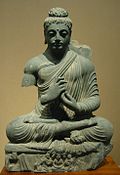
A | B | C | D | E | F | G | H | CH | I | J | K | L | M | N | O | P | Q | R | S | T | U | V | W | X | Y | Z | 0 | 1 | 2 | 3 | 4 | 5 | 6 | 7 | 8 | 9
| Part of a series on |
| Mahāyāna Buddhism |
|---|
 |
Mādhyamaka ("middle way" or "centrism"; Chinese: 中觀見; pinyin: Zhōngguān Jìan; Tibetan: དབུ་མ་པ་ ; dbu ma pa), otherwise known as Śūnyavāda ("the emptiness doctrine") and Niḥsvabhāvavāda ("the no svabhāva doctrine"), refers to a tradition of Buddhist philosophy and practice founded by the Indian Buddhist monk and philosopher Nāgārjuna (c. 150 – c. 250 CE).[1][2][3] The foundational text of the Mādhyamaka tradition is Nāgārjuna's Mūlamadhyamakakārikā ("Root Verses on the Middle Way"). More broadly, Mādhyamaka also refers to the ultimate nature of phenomena as well as the non-conceptual realization of ultimate reality that is experienced in meditation.[4]
Since the 4th century CE onwards, Mādhyamaka philosophy had a major influence on the subsequent development of the Mahāyāna Buddhist tradition,[5] especially following the spread of Buddhism throughout Asia.[5][6] It is the dominant interpretation of Buddhist philosophy in Tibetan Buddhism and has also been influential in East Asian Buddhist thought.[5][7]
According to the classical Indian Mādhyamika thinkers, all phenomena (dharmas) are empty (śūnya) of "nature",[8] of any "substance" or "essence" (svabhāva) which could give them "solid and independent existence", because they are dependently co-arisen.[9] But this "emptiness" itself is also "empty": it does not have an existence on its own, nor does it refer to a transcendental reality beyond or above phenomenal reality.[10][11][12]
Etymology
Madhya is a Sanskrit word meaning "middle". It is cognate with Latin med-iu-s and English mid. The -ma suffix is a superlative, giving madhyama the meaning of "mid-most" or "medium". The -ka suffix is used to form adjectives, thus madhyamaka means "middling". The -ika suffix is used to form possessives, with a collective sense, thus mādhyamika mean "belonging to the mid-most" (the -ika suffix regularly causes a lengthening of the first vowel and elision of the final -a).
In a Buddhist context, these terms refer to the "middle path" (madhyama pratipada), which refers to right view (samyagdṛṣṭi) which steers clear of the metaphysical extremes of annihilationism (ucchedavāda) and eternalism (śasvatavāda). For example, the Sanskrit Kātyāyanaḥsūtra states that though the world "relies on a duality of existence and non-existence", the Buddha teaches a correct view which understands that:[13]
Arising in the world, Kātyayana, seen and correctly understood just as it is, shows there is no non-existence in the world. Cessation in the world, Kātyayana, seen and correctly understood just as it is, shows there is no permanent existence in the world. Thus avoiding both extremes the Tathāgata teaches a dharma by the middle path (madhyamayā pratipadā). That is: this being, that becomes; with the arising of this, that arises. With ignorance as condition there is volition ... [14]
Though all Buddhist schools saw themselves as defending a middle path in accord with the Buddhist teachings, the name madhyamaka refers to a school of Mahayana philosophy associated with Nāgārjuna and his commentators. The term mādhyamika refers to adherents of the madhyamaka school.
Note that in both words the stress is on the first syllable.
Philosophical overview
| Part of a series on |
| Buddhist philosophy |
|---|
 |




